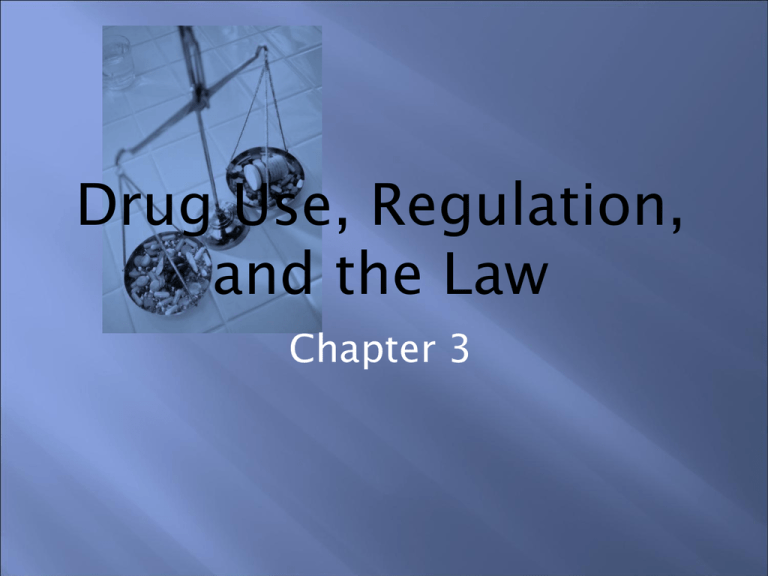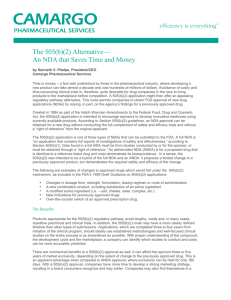Drug Slides Ch. 3
advertisement

Drug Use, Regulation, and the Law Chapter 3 Society has the right to protect itself from the damaging impact of drug use. Society has the right to demand safe and effective drugs. Milestones in Food and Drug History Law Do you believe that drugs should be highly regulated? Why or why not? What are the positive points to consider with a high amount of drug regulation? What are the negative points? Why do you believe we have very strict regulations on the drug industry? The term patent medicines (video) signified that the ingredients were secret, not patented. The patent medicines of the late 1800s and early 1900s demonstrated the problems of insufficient regulation of the drug industry. Patented medications could / would contain drugs that were addictive and cause severe dependence on the medication Required manufacturers to include on labels the amounts of alcohol, morphine, opium, cocaine, heroin, or marijuana extract in each product Made misrepresentation of drugs as “nonhabit forming” illegal Did not prohibit distribution of dangerous preparations Accuracy of manufacturers’ therapeutic claims was not controlled by the Pure Food and Drug Act. The Sherley Amendment in 1912 was passed to strengthen existing laws and required that labels should not contain “any statement ... regarding the curative or therapeutic effect ... which is false and fraudulent.” In 1937 - Elixir of Sulfanilamide, containing the poisonous solvent diethylene glycol, kills 107 persons, many of whom are children, dramatizing the need to establish drug safety before marketing and to enact the pending food and drug law.. Companies required to file applications with the government showing that new drugs were safe. Companies required to file applications with the government showing that new drugs were safe. Defined drugs to include products that affect bodily structure or function even in the absence of disease. Drug labels had to list all ingredients and provide instructions regarding correct use and warnings about its dangers. Made formal distinction between prescription and nonprescription drugs Established drug classification categories Drug is habit-forming Drug is not safe for self-medication Drug is a new drug and not shown to be completely safe Passed, in part, as a consequence of the thalidomide tragedy Drug manufacturers had to demonstrate the efficacy and safety of drugs The FDA was empowered to withdraw approval of a drug that was already being marketed The FDA was permitted to regulate and evaluate drug testing by pharmaceutical companies The amended Food, Drug, and Cosmetic Act requires that all new drugs be registered with and approved by the FDA. Historical Summary of the FDA The FDA is mandated by Congress to: Ensure the rights and safety of human subjects during clinical testing Evaluate the safety and efficacy of new treatments Compare benefits and risks of new drugs and determine if approval for marketing is appropriate Step 1: Preclinical research and development Step 2: Clinical research and development Initial clinical stage Clinical pharmacological evaluation stage Extended clinical evaluation Step 3: Permission to market Post-marketing surveillance New Drug Application (NDA) For decades, the regulation and control of new drugs in the United States has been based on the New Drug Application (NDA). Since 1938, every new drug has been the subject of an approved NDA before U.S. commercialization. The NDA application is the vehicle through which drug sponsors formally propose that the FDA approve a new pharmaceutical for sale and marketing in the U.S. The data gathered during the animal studies and human clinical trials of an Investigational New Drug become part of the NDA. Source: http://www.fda.gov/Drugs/DevelopmentApprovalProcess/HowDrugsareDevelopedandApproved/ApprovalApplica tions/NewDrugApplicationNDA/default.htm The goals of the NDA are to provide enough information to permit FDA reviewer to reach the following key decisions: Whether the drug is safe and effective in its proposed use(s), and whether the benefits of the drug outweigh the risks. Whether the drug's proposed labeling (package insert) is appropriate, and what it should contain. Whether the methods used in manufacturing the drug and the controls used to maintain the drug's quality are adequate to preserve the drug's identity, strength, quality, and purity. If there is sufficient data to demonstrate that a drug is safe and effective, the company submits an NDA as a formal request that the FDA approve it for marketing. Source: http://www.fda.gov/Drugs/DevelopmentApprovalProcess/HowDrugsareDevelopedandApproved/Approval Applications/NewDrugApplicationNDA/default.htm “Fast-track” rule Applied to testing of certain drugs, such as ones for rare cancers and AIDS Orphan Drug Law Tax advantages for development of drugs to treat “rare diseases” since this can be otherwise unprofitable Prescription Drug User Fee Act of 1992 Increase reviewers and decrease review time In 1972, the FDA initiated a program to evaluate the effectiveness and safety of nonprescription drugs. The FDA evaluated each active ingredient in OTC medications and placed ingredients into three categories: I. Safe and effective II. Not safe and effective or unacceptable indications III. Insufficient data to permit final classification This policy allows the FDA to review prescription drugs and evaluate their suitability as an OTC. The drug must have been used by prescription for 3 years. Use must have been relatively high during the time it was used by prescription. Adverse drug reactions must not be alarming, and the frequency of side effects must not have increased during the time the drug was available to the public. Promotional efforts by pharmaceutical companies have a large impact on the drugpurchasing habits of the general public and health professionals. As a general rule, the FDA oversees most issues related to advertising of prescription products. The FTC regulates OTC and dietary supplement advertising. This form of advertising is directed toward patients, rather than healthcare professionals. Most physicians surveyed agreed that because their patient saw a DTC advertisement, he/she asked thoughtful questions during the visit. Approximately the same percentage of physicians thought the advertisements made their patients more aware of possible treatments. The physicians surveyed indicated that the advertisements did not convey information about risks and benefits equally well. Approximately 75% of physicians surveyed indicated that DTC ads cause patients to think that the drug works better than it does, and many physicians felt some pressure to prescribe something when patients mentioned DTC ads. The physicians surveyed reported that patients understand that they need to consult a health care provider concerning appropriate treatments. Misleading Ads and the FDA (Forbes Magazine) Research on DTC ads in Canada Marked the first legitimate effort by the federal government to regulate and control the production and importation of addicting substances Federal Laws Associated with Drug Abuse This 1970 act divided substances with abuse potential into categories based on the degree of their abuse potential and clinical usefulness. Schedules I, II, III, IV, and V Schedule I substances have high-abuse potential and no currently approved medicinal uses; they cannot be prescribed. Schedule II substances have high-abuse potential but are approved for medical uses and can be prescribed. Schedule II–V substances reflect the likelihood of abuse and clinical usefulness. The actual or relative potential for abuse of the drug. Scientific evidence of the pharmacological effects of the drug. The state of current scientific knowledge regarding the substance. Its history and current pattern of abuse. What, if any, risk there is to the public health. The psychological or physiological dependence liability of the drug. The scope, duration, and significance of abuse. Whether the substance is an immediate precursor of a substance already controlled. See Controlled Substance Schedules, p. 114, next slide If a person abuses a drug, should he or she be treated as a criminal or as a sick person inflicted with a disease? How is the user (supposedly the victim) distinguished from the pusher (supposedly the criminal) of an illicit drug, and who should be more harshly punished? Are the laws and associated penalties effective deterrents against drug use or abuse, and how is effectiveness determined? Federal Trafficking Penalties Source: DEA. Available at: http://www.usdoj.gov/dea/agency/penalties.htm. Federal Trafficking Penalties (continued) Source: DEA. Available at: http://www.usdoj.gov/dea/agency/penalties.htm. • Supply Reduction – Attempts to curtail the supply of illegal drugs or their precursors and exert greater control over other, more therapeutic drugs – Includes interdiction, the policy of cutting off or destroying supplies of illicit drugs – Limited success • Inoculation – Aims to protect drug users by teaching them responsibility and explaining the effects of drugs on bodily and mental functioning • Demand Reduction – Aims to reduce the actual demand for drugs A top priority of prevention is to reduce demand by youth. Education must be carefully designed for the target population. Attitudes toward drug abuse must be changed. Replacement therapy can be useful. Drug Courts • Designed to deal with nonviolent, drug-abusing offenders • Integrate mandatory drug testing, substance abuse treatment, sanctions, and incentives in a judicially supervised setting © BrandX Pictures/Creatas Violence and crime would decrease/increase? Profits associated with illegal trade would decrease/increase? Law enforcement costs would decrease/increase? Addiction would decrease/increase? Societal/health costs would decrease/increase? Consumption would increase/decrease? In response to the demand by society to stop the spread of drug abuse and its adverse consequences, drug testing has been implemented in some situations to detect drug users. Breathalyzers Urine, blood, and hair specimens The government must develop programs that are consistent with the desires of the majority of the population. Programs must consider de-emphasizing interdiction (“War on Drugs”) and stress programs that reduce demand. Government and society must better understand how laws, used properly and selectively, can reinforce and communicate expected social behavior and values. Programs, such as anti-smoking campaigns, should be implemented that employ “public consensus” more effectively.







